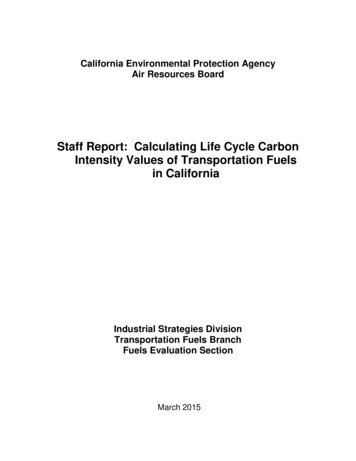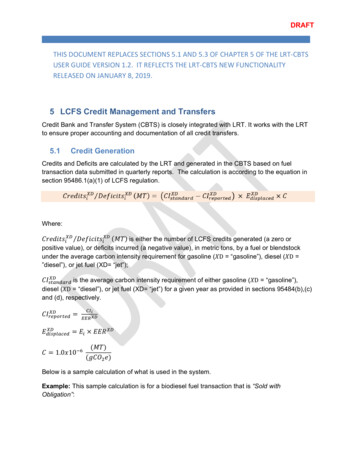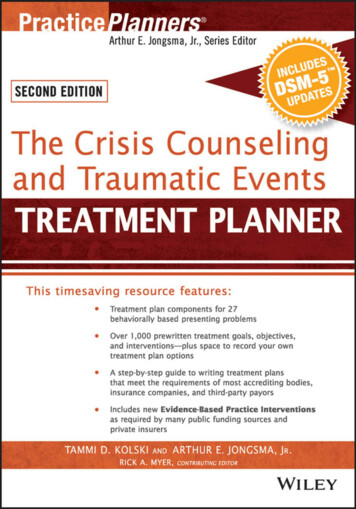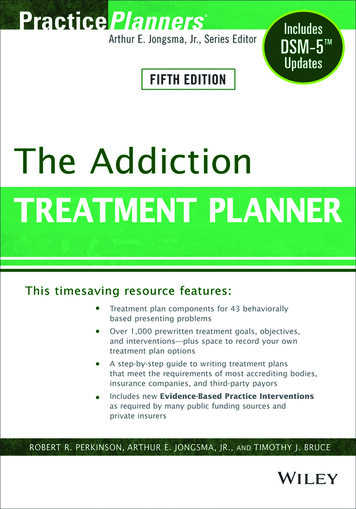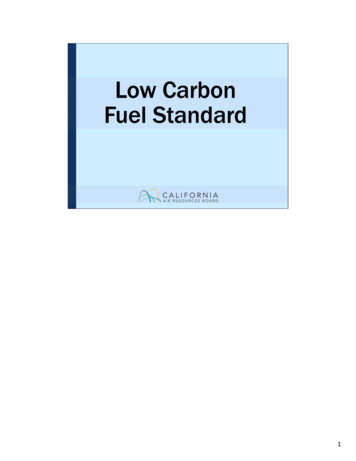
Transcription
1
2
In 2009 the Board approved the LCFS regulation to reduce the carbon intensity (CI) oftransportation fuel used in California by at least 10 percent by 2020 from a 2010 baseline.In 2011, the Board approved amendments to clarify, streamline, and enhance certainprovisions of the regulation. In 2015, the Board re‐adopted the LCFS to address proceduralissues, which began implementation on January 1, 2016. In 2018, the Board approvedamendments to the regulation, which includes strengthening and smoothing the CIbenchmarks through 2030 in‐line with California’s 2030 GHG target enacted through SB32.The LCFS is one of the key AB 32 measures to reduce greenhouse gas emissions inCalifornia but also has other significant benefits. It transforms and diversifies the fuel poolin California to reduce petroleum dependency and achieves air quality benefits, which areState priorities that preceded AB 32.3
The LCFS is designed to reduce GHG emissions in the transportation sector, which isresponsible for about 50 percent of GHG emissions (including industrial sector emissionsfrom refining and crude production), 80 percent of ozone‐forming gas emissions, and over95 percent of diesel particulate matter.It is a key part of a comprehensive set of programs in California to reduce emissions fromthe transportation sector, including the Cap and Trade Program, Advanced Clean CarsProgram, and SB 375.4
The LCFS sets annual carbon intensity (CI) standards, or benchmarks, which reduce overtime, for gasoline, diesel, and the fuels that replace them.Carbon intensity is expressed in grams of carbon dioxide equivalent per megajoule ofenergy provided by that fuel. CI takes into account the GHG emissions associated with allof the steps of producing, transporting, and consuming a fuel—also known as a completelife cycle of that fuel.The LCFS lets the market determine which mix of fuels will be used to reach the programtargets.5
Fuels and fuel blendstocks introduced into the California fuel system that have a CI higherthan the benchmark generate deficits. Similarly, fuels and fuel blendstocks with CIs belowthe benchmark generate credits. Annual compliance is achieved when a regulated partyuses credits to match its deficits.Since the regulation was first adopted, the compliance curves have been “back‐loaded” toallow time for the development of low‐CI fuels and advanced vehicles (the benchmark CIreduction was frozen by court order for three years between 2013 and 2015). Due to thisprogram design choice, there has always been the expectation that excess creditsgenerated in the early years of the program would be available for use in more stringentfuture years, if needed.Under the current LCFS regulation, the 2030 standard of a 20 percent CI decline will also beimposed for all years post‐2030.6
7
Since the regulation went into effect, low carbon fuel use has increased. Fuel producersare also taking action to decrease the carbon intensity of their fuels.The program has an established market for credit transactions. The total value of credittransactions exceeded 2 billion in 2018.The LCFS Data Dashboard web page was created to display the current and historical LCFSprogram data. Some of the information found in the Data Dashboard are the following: Volume of fuels and credits generated under the LCFS Compliance curve and the percent reduction in carbon intensity to date Credit volumes transacted and the average credit prices per month under the LCFS.To see the Data Dashboard, please board.htm.8
Other jurisdictions are joining California, which is evident in the Pacific Coast Collaborative,a regional agreement between California, Oregon, Washington, and British Columbia tostrategically align policies to reduce greenhouse gases and promote clean energy.One of the provisions of this Collaborative explicitly addresses Low Carbon Fuel Standardprograms. California, Oregon, and British Columbia have existing LCFS programs in placeand the Washington legislature is considering a program.Staff has been routinely working with these jurisdictions, providing assistance where wecan. Over time, these LCFS programs will build an integrated West Coast market for low‐carbon fuels that will create greater market pull, increased confidence for investors of lowcarbon alternative fuels, and synergistic implementation and enforcement programs.Other regions including Canada and Brazil are also noticing California’s success anddeveloping LCFS‐like performance standards for transportation fuels.9
10
There are three ways to generate credits in the LCFS: fuel pathways, projects, and capacity‐based crediting.Under fuel pathway‐based crediting, all transportation fuels need a carbon intensity scoreto participate in the LCFS, and the fuel type dictates which process is used to determinethat CI. Providers of low carbon fuels used in California transportation generate credits byobtaining a certified CI and reporting transaction quantities on a quarterly basis. Creditsare calculated relative to the annual CI benchmark and will undergo verification post creditgeneration.Under project‐based crediting, projects include actions to reduce GHG emissions in thepetroleum supply chain, and also CCS using Direct Air Capture. Crediting for projects isbased on life cycle emission reductions, and credits are issued after the reportedreductions are verified.Finally, the 2018 amendments added a new crediting mechanism to the LCFS which isdesigned to support the deployment of zero emission vehicle infrastructure. Crediting forZEV infrastructure is based on the capacity of the hydrogen station or EV fast charging siteminus the actual fuel dispensed.11
The Alternative Fuels Portal (AFP) and the LCFS Credit Banking and Transfer System (LRT‐CBTS) are two of the modules thatmake up the LCFS database management system. Not depicted here is the Verification module, which will provide access toparticipant data for LCFS‐accredited Verification Bodies.The AFP facilitates the application process to obtain a certified CI score. Applicants for Tier 1 and Tier 2 pathways, which relyon site‐specific data, use this portal to submit their CI calculator and supplemental information.All Lookup Table CI values were historically obtained through the LRT‐CBTS. Beginning in 2019, all applicants for HydrogenLookup Table pathways will apply through the AFP, along with applicants for the Zero‐CI Electricity Lookup Table pathway.Entities seeking any other Lookup Table pathway, including CARBOB, ULSD, California Average Grid Electricity, CNG, LPG, andSmart Charging or Smart Electrolysis, do not need to register in the AFP and will continue to use the LRT‐CBTS.The LRT‐CBTS is designed specifically to facilitate reporting and credit banking and transfers. Beginning in 2019 it will also beable to process project‐based crediting and ZEV infrastructure crediting applications.Entity requirements and responsibilities are defined by the role each entity plays. An entity may have multiple roles in theLCFS, such as an alternative liquid fuel producer may be a Fuel Pathway applicant, but because this entity also reports andgenerates credits, they are a fuel reporting entity as well. A hydrogen station owner who generates infrastructure credits mustalso be a fuel reporting entity (to report the quantity of fuel dispensed); this entity may also be a pathway holder, or anotherentity could have taken the responsibilities of applying for and maintaining the pathway. All fuel pathway applicants becomefuel pathway holders once their CI is certified; they must annually demonstrate that the pathway remains valid.Note that applications for carbon capture and sequestration may be approved through the: AFP (fuel pathway‐based crediting) if the capture occurs within the process of an alternative fuel pathway, e.g., CO2 fromethanol fermentation LRT (project‐based crediting) if the capture is associated with crude oil production (Innovative Crude provisions) or apetroleum refinery (Refinery Investment Credit provisions), or by direct air capture (not associated with any fuel; may becredited as a stand‐alone project).To access the LRT‐CBTS and AFP, please see path /lcfsrt/Login.aspx.12
The LCFS regulation does not apply to an alternative fuel that is not a biomass‐based fuel oris supplied in California with an aggregated quantity of less than 420 million MJ/year.Conventional jet fuel, aviation gasoline, deficit‐generating fuel used in military tacticalvehicles, and credit‐generating fossil CNG or fossil propane dispensed at a fueling stationwith total throughput of 150,000 gasoline‐gallons equivalent or less per year (until 2021 or2024, respectively) are also exempt from the LCFS. The LCFS regulation also does not applyto fuels used in interstate locomotives, ocean‐going vessels, and deficit‐generating fossilpropane and CNG used in school buses purchased prior to January 1, 2020.13
Credits and deficits are calculated using the carbon intensity benchmarks for gasoline anddiesel fuel in each calendar year. These benchmarks equate to a 6.25 percent reduction incarbon intensity relative to 2010 in the 2019 compliance year, increasing linearly to a 20percent reduction in 2030.14
Since conventional jet fuel is not subject to the LCFS regulation and does not generatedeficits, these carbon intensity benchmarks are used specifically to calculate credits fromalternative jet fuel. The jet fuel benchmarks remain fixed at the 2010 baseline CI forconventional jet fuel, with a zero percent reduction in each year, until the benchmark fordiesel substitutes declines below the CI baseline for jet fuel, in 2023. The jet fuelbenchmarks then mirror the benchmarks for diesel through 2030.15
The CI includes the “direct” effects of producing and using the fuel, as well as “indirect”effects that are primarily associated with crop‐based biofuels. Two models are used tocalculate the direct effects, which are the California Greenhouse Gases, RegulatedEmissions, and Energy Use in Transportation (CA‐GREET) and Oil Production Greenhousegas Emissions Estimator (OPGEE) models. To calculate the indirect effects, the Global TradeAnalysis Project (GTAP) model was updated and the Agro‐Ecological Zone Emissions Factor(AEZ‐EF) model was created to supplement GTAP’s estimates of greenhouse gas emissionsfrom various types of land conversions.16
This is an illustration of the life cycle assessment of California Reformulated GasolineBlendstock for Oxygenate Blending (CARBOB). CARBOB makes up the petroleum fraction ofCalifornia reformulated gasoline (CaRFG) before any fuel oxygenate is added; CARFG isessentially 90 percent CARBOB blended with 10 percent ethanol by volume.CARBOB CI is based on the 2010 average crude oil supplied to California refineries andaverage California refinery efficiencies. Crude oil is evaluated using the OPGEE model; thecrude supplied to California refineries in 2010 was found to have an average CI of 11.78gCO2e/MJ, with some crudes ranging from as low as 4 to as high as 30 gCO2e/MJ.Production of CARBOB at all California refineries adds 14.8 g/MJ to the fuel cycle CI. About75 percent of the GHG emissions from the life cycle of CARBOB occur during combustion invehicles (tailpipe emissions).17
This is an illustration of the life cycle assessment of corn ethanol. Emissions associated with agriculturecontribute 29 gCO2e/MJ; of that, 11 g result from the production of fertilizer and soil amendments, and thesoil emissions resulting from synthetic and organic additions contribute an additional 14 g/MJ, and on‐farmemissions from energy use in tractors during activities such as planting, cultivation and harvest, make up theremainder.Emissions from production at the ethanol facilities vary widely depending on their process fuels, theirefficiencies, and any processing of co‐products, such as drying distiller’s grains and solubles (DGS). Pleasenote that this slide contains numerical values for illustrative purposes only.DGS is the remnants of the corn after fermentation and is sold and used as livestock feed. A credit of ‐12g/MJ is assessed for the production of DGS at a typical rate of 5.31 dry pounds per gallon of ethanol; thiscredit reflects market displacement of corn and other feed ingredients from LCFS applicationContributing substantially to the impacts associated with corn (and other crops) used to produce biofuels isthe phenomenon called land use change, or LUC. LUC occurs when higher ethanol demand increases thedemand for corn, raising its market price. Someone, somewhere, reacting to this price signal, will convertland to corn production, either directly or through a series of daisy‐chain events, which will result in carbonemissions from that land. The estimated amount of land conversion and associated GHG emissions aredetermined using the GTAP and AEZ‐EF models and are added to the CI of corn ethanol. All crop‐basedfeedstocks have LUC values.Finally, the CO2 emitted from vehicles during biofuel combustion is considered carbon neutral, in accordancewith IPCC and U.S. EPA GHG inventory guidelines, as the carbon released was uptaken from the atmosphereby the corn within a short timeframe. Additionally, ethanol is required to be denatured in order to render itunfit for human consumption. A small amount of gasoline blendstock is added, typically 2.5%v/v, for thispurpose, adding 1 g/MJ to the CI of denatured ethanol.18
This is an illustration of the life cycle assessment of biodiesel made from used cooking oil(UCO). UCO, also known as waste grease, is collected from sites like industrial foodprocessors and restaurants. The UCO is transported to a rendering facility where it isfiltered and purified to remove any water, solids, contaminants, to reduce the level of freefatty acids (FFA) and ensure the oil has the correct properties required for fuel production.The rendered oil is then transported to a biorefinery where it is converted to biodiesel byreacting with methanol in a chemical process called esterification. The process also yieldsa co‐product, glycerin; an accounting method known as energy‐based allocation is used todivide the total emissions from the facility between its two products. 95 percent of theproduction emissions are attributed to biodiesel and the remaining 5 percent to glycerin.Please note that this slide contains numerical values for illustrative purposes only.The CO2 emitted from vehicles during biofuel combustion is considered carbon neutral, inaccordance with IPCC and U.S. EPA GHG inventory guidelines, as the carbon released wasuptaken from the atmosphere within a short timeframe by the plant that produced the oil.A small amount of emissions, less than 1 g/MJ, result from the GHGs (methane and nitrousoxide) that form during biodiesel combustion.19
This is an illustration of the life cycle assessment of California’s average grid electricity when it isused to charge Electric Vehicles (EV).The carbon intensity of California electricity is calculated in CA‐GREET 3.0 using the 2017 averageCalifornia generation resource mix from the CEC database1 , slightly modified to match CA‐GREETresource categories2 in order to calculate the emissions associated with each resource.The GHG emissions for this pathway consist of the upstream emissions associated with producingand transporting each fuel to the power plant, the emissions associated with generating electricity(combustion of fossil based resources like natural gas), and transmission line losses (translated toemissions from the excess electricity that must be supplied to meet demand).Finally, EVs in the Light‐duty Vehicles (LDV) and Medium‐duty Vehicles (MDV) are over three timesmore efficient than the internal combustion engines (ICE) they replace. The life cycle emissionsfrom electricity generation sum up to 81.49 gCO2/MJ of electricity, but the effective CI shown hereis on the basis of the amount of gasoline that is displaced by the use of EVs. The efficiency ratio is,therefore, translated to an emission savings representing the smaller amount of energy an EVneeds to travel the same distance as an ICE.12017 California Total System Electric Generation, California Energy ricity data/total system power.html2 California Air Resources Board, CA‐GREET 3.0 Supplemental Document and Tables of Changes, 13‐AUG‐2018: et supp doc clean.pdf20
This illustration shows the stages that are analyzed while performing life cycle assessment of compressed naturalgas (CNG) from landfill gas (LFG). LFG is also known as biogas as it originates from organic materials whichdecompose without oxygen in landfills, resulting in generation of methane. Biogas is typically 50‐60% methane andthe remainder is made up of CO2 and trace gases.Recovery of biogas is accomplished using electrical fans to draw gas up through wells inserted throughout a landfill.Most landfills are required to capture LFG and oxidize methane to CO2 by the use of a flare or thermal oxidizer. Bycapturing and using this gas as a transportation fuel rather than flaring, CO2 emissions are avoided.Capture mechanisms are imperfect, resulting in an estimated 25 percent of LFG that escapes the flare; this emissionis considered outside of the LCA system boundary, as it occurs whether a landfill is capturing gas for use as a fuel, orfor flaring. This is a principle of life cycle assessment, which seeks to determine what emissions would occur in areference or baseline scenario, and compares the project case in order to determine the net change caused by aprocess or product.Biogas upgrading is where the majority of the emissions associated with LFG to CNG occur. The objective is toremove CO2, water, and to scrub unwanted components such as hydrogen sulfide in order to bring the biogas topipeline‐quality and motor vehicle standards. At this stage the gas is referred to as biomethane.Transmission via the system of natural gas pipelines that span the U.S. can also result in a significant quantity ofemissions, for a conservative distance from a landfill to CA, 3,600 miles pipeline is chosen. Compressors requireenergy to move gas through pipelines, and methane has opportunities to escape during gas transmission; themagnitude of emissions is dependent on the distance gas travels from its source to its end use.When pipeline gas is withdrawn at a refueling station, it is compressed to CNG before it is injected into a vehicle.The tailpipe emissions that occur during combustion of CNG in a natural gas engine for methane and nitrous oxideonly; CO2 is cancelled with the avoidance of the combustion of a flare. Please note that this slide containsnumerical values for illustrative purposes only.21
All transportation fuels need a carbon intensity score to participate in the LCFS, and the fuel typedictates which process is used to determine that CI.Lookup Table pathways have CI scores that are predetermined by CARB using industry‐wideaverage inputs, or conservative assumptions. Most of the fuels in the Lookup Table don’t requirean application, and those that do require an application have a few requirements and a verystreamlined approval process.The Tier 1 pathway application process is for the most common low carbon fuels, and applicantsuse a Simplified CI Calculator to determine their site‐specific fuel production and transportemissions. Under Tier 1, most emissions from feedstock production are based on standard inputs,but the calculators have some flexibility to accommodate user‐defined process energy inputs.The Tier 2 application process is designed for innovative, next‐generation pathways, which may useunique feedstocks or include advanced technologies like Carbon Capture and Sequestration. Tier 2fuels include Alternative jet fuel, and any other pathway that is not eligible to use the Lookup Tableor Tier 1 process. Applicants for these pathways can fully customize the California GREET model toaccurately determine their site‐specific CI.The diagram shows the basic process for credit generation. Credits for fuel pathways are calculatedbased on the CI score that is determined in the initial pathway application, the energy economyratio or EER for the type of vehicle the fuel is used in, and the quantity of fuel reported. Credits areissued quarterly, and pathways with site‐specific CI data will typically be verified annually.22
A regulated entity’s annual compliance obligation is met when the regulated entitydemonstrates via its annual report that it possessed and has retired a number of creditsfrom its credit account that is equal to its compliance obligation. The annual complianceperiod is January 1st through December 31st of each calendar year.Fuel transactions from each calendar quarter are reported during the next calendarquarter. After each deadline, no credits can be generated for an activity that took place inthe prior quarter. Transactions involving business partners must be reconciled by the“Deadline” dates shown in the LCFS Reporting Schedule table. The quarterly reportingschedule is as follows: June 30th: For the first calendar quarter covering January through MarchSeptember 30th: For the second calendar quarter covering April through JuneDecember 31st: For the third calendar quarter covering July through SeptemberMarch 31st: For the fourth calendar quarter covering October through DecemberThe annual compliance reports must be submitted by April 30th of each year.For more information on the LRT‐CBTS and AFP, or to submit quarterly or annual reports,please visit the Data Management System web l/datamanagementsystem.htm.23
A system for third‐party verification is needed to ensure accuracy of reported greenhousegas data. The framework and principles of the LCFS verification program are consistentwith the verification systems that support CARB’s Cap‐and‐Trade program. The LCFSverification program provides confidence and reliability in reported data for stakeholders,market participants, and the public—the data have financial implications and qualityassurance must meet a specified level of rigor.Third‐party verification is international best practice for credible greenhouse gasmonitoring and reporting and considered a requirement for carbon pricing systems. Theverification program is based on ISO 14064‐3 and 14065. It also provides a systematic,independent, and documented process for evaluation of reported data against the LCFSregulatory requirements and methods for calculation.Beginning in 2019, verifiers will apply for CARB accreditation and take required training andexam(s). CARB will publish on the LCFS website the list of verification bodies and verifiersaccredited to perform LCFS verification services.24
The entities required to contract for verification services are summarized here.Regulated entities specified in section 95500 are required to retain the services ofindependent verifiers accredited by CARB, beginning with 2020 fuel pathway applicationsand in 2021 for LCFS data reports, and thereafter. Deferred verification statements are duein 2023 for those who are eligible.25
The LCFS Regulation includes requirements for data accuracy and meter calibration.Reported LCFS data have financial implications and must meet the specified level of rigor.All entities that submit LCFS data used to calculate GHG emissions and reductions mustattest to its accuracy. Most LCFS data are based on financial transaction meters that meetCARB’s accuracy requirements: suppliers and purchasers who do not have common ownersrely on the measurements for sales, meters are sealed with a valid seal from the countysealer of weights and measures or from a county certified designee, or third partiesoperate the meters. Meters that do not meet the criteria above, referred to as “internalmeters,” must be installed, operated, and maintained according to manufacturer‐recommended calibration frequency and precision requirements to meet accuracyrequirements for LCFS data. In addition, entities responsible for obtaining third‐partyverification must document measurement device information in a written Monitoring Planaccording to section 95491.1(c) and demonstrate acceptable measurement accuracy. Ifdata are missing, the regulated entity must be able to demonstrate to the verifier thatreported data are accurate within /‐ 5 percent or must obtain CARB approval of analternate monitoring method pursuant to section 95488.8(k).26
If a regulated party does not retire sufficient credits to meet its compliance obligation, thena Credit Clearance Market will be initiated. Entities with credits to sell can opt to pledgecredits into the market and entities needing credits must purchase their pro‐rata share ofthese pledged credits. A price cap in the clearance market prevents extreme marketvolatility, thereby providing consumer protection.27
The LCFS contains two credit opportunities for refineries, an expanded credit opportunityfor crude production, and Carbon Capture and Sequestration by Direct Air Capture.The renewable hydrogen refinery credit provision allows refineries to generate creditsthrough the use of renewable hydrogen at the refinery to produce gasoline and diesel.Renewable hydrogen can be produced using steam methane reforming of renewablenatural gas or through electrolysis using renewable electricity.The refinery investment credit provision allows refineries to generate credits for GHGreduction projects undertaken at a refinery. These projects include use of renewableenergy sources, conversion of combustion power sources to electricity, use of carboncapture and sequestration, and process improvement projects.The innovative crude credit provision supports innovative technologies for solar steam orheat generation, solar‐ or wind‐based electricity, renewable natural gas or biogas energy,and carbon capture and sequestration.28
Projects claiming CCS credits must comply with the CCS Protocol. Credits must be proratedbased on the volumes delivered to California, except for direct air capture projects.The amount of net CO2 sequestered by alternative fuel producers can be used to adjust thecarbon intensities of the associated fuel pathways.All CCS projects must undergo verification.29
Examples of how the CCS Protocol can be used in the LCFS include low carbon fuelpathway, refinery investment, innovative crude, or direct air capture.To generate credits for CCS projects, credits go to the capture facility. The storage facilitymust also be a co‐applicant, but capture and storage facilities do not need to be co‐located.All CCS projects must receive a Permanence Certification before LCFS credit generation ispossible.Recognized reservoirs under the LCFS include saline formations, CO2 enhanced oil recovery,and depleted oil and gas reservoirs.30
Electric vehicles, trucks, electric transit systems (fixed guideway, buses), electric forklifts,electric cargo‐handling equipment, electric transportation refrigeration units, and shorepower to ocean‐going vessels at‐berth are eligible to generate credits.Due to the fact that consumer preferences of electric vehicle owners has not resulted inwidespread installation of separate metering in residences, CARB calculates the credits fornon‐metered residential charging of EVs, to maintain the quality and accuracy of the creditgenerations. Electrical Distribution Utilities (EDU) earn “base” credits for all residentialcharging using the grid average CI, and the load serving entity, auto manufacturer, oranother entity may also generate “incremental” credits for supplying metered, low‐CIelectricity or smart charging to those residences. In the event that multiple entities claimincremental credits for a given residence, the LCFS provides the following order of priority:the Load‐Serving Entity (LSE), including a Community Choice Aggregator (CCA); theautomobile manufacturer who provides metered charging data through on‐vehicletelematics; and any other entity who can provide the metered data has the third priority,which could include a charging service provider or an aggregator. All electricity creditgenerators must use credit proceeds to promote transportation electrification, and providebenefits to their EV customers and educate them about the benefits of EV transportation.The LCFS streamlines and facilitates the credit generation and reporting for public,workplace and fleet charging. Utilities will receive those credits unless electrical vehicleservice providers, site hosts or fleet owners opt in.31
The combination of zero‐carbon electricity and zero‐emission vehicles offers significantopportunity for reductions that are not well recognized by the program to date. To addressthis issue, the 2018 amendments allow renewable power generated off‐site to be used inEV charging and hydrogen production by electrolysis. The amendments also recognize thebenefits of shifting EV charging and electrolyzer loads to periods of time when excessrenewable electricity might otherwise be wasted. These amendments are intended to be afirst step in promoting further expansion of zero‐emission vehicle infrastructure throughthe LCFS, as directed by the Governor’s Executive Order. They would help make thesevehicles fully “zero emission” on a life cycle basis.32
The LCFS also contains hydrogen provisions. The person who owns the hydrogen fuelingsupply equipment or the hydrogen forklift fleet is eligible to generate credits for hydrogenfueling. Lookup Table pathways for hydrogen produced in California are available tostreamline participation. Hydrogen is an opt‐in fuel until statewide use in transportationmeets a threshold of 3,500 tons per year.To
programdata. Some of the information found in the Data Dashboard are the following: Volume of fuels and credits generated under the LCFS Compliance curve and the percent reduction in carbon intensity to date Creditvolumes transacted and the average credit prices per month under the LCFS. To see the Data Dashboard, please see


